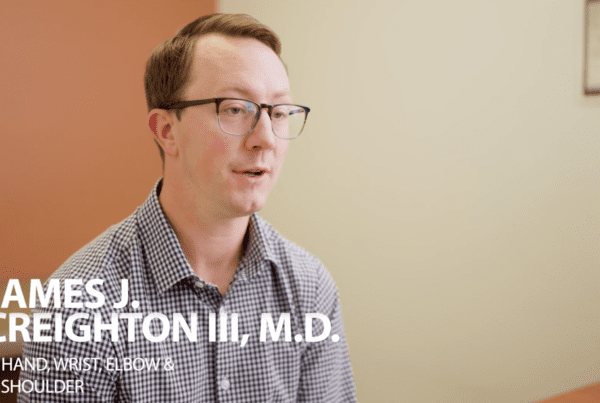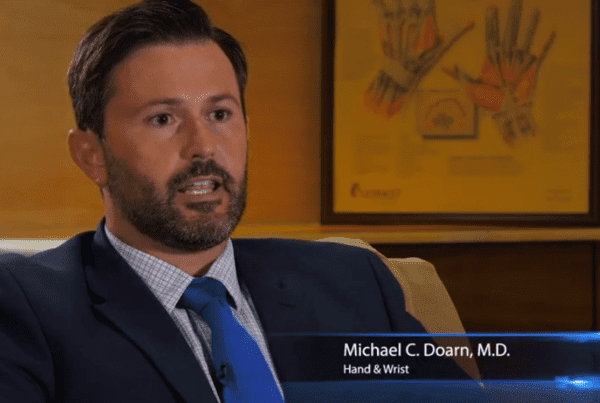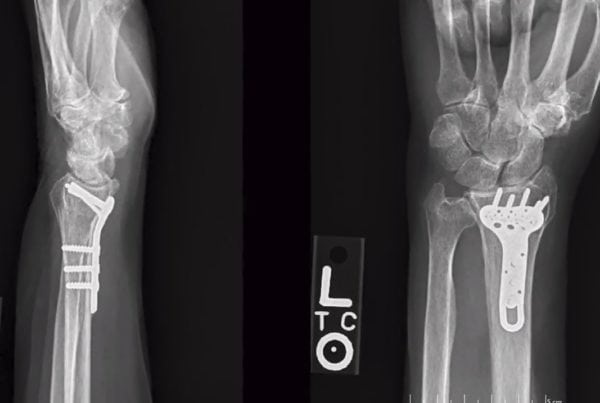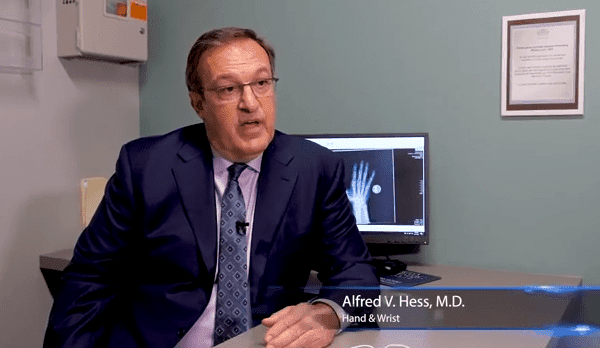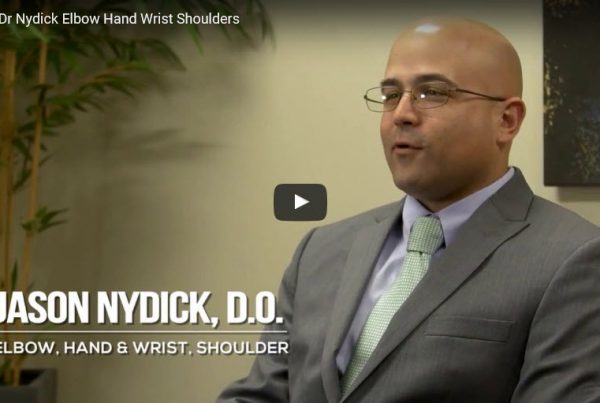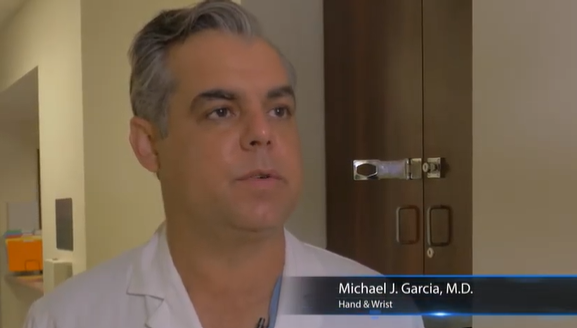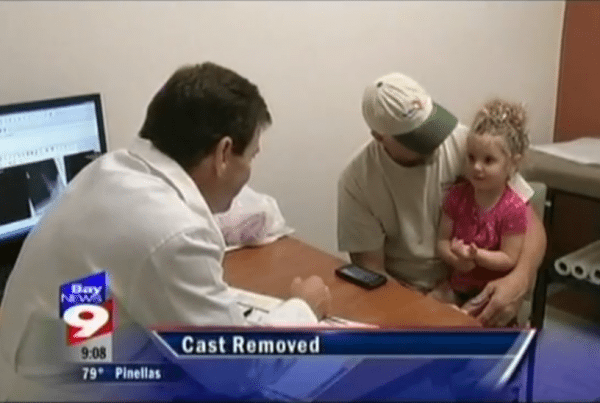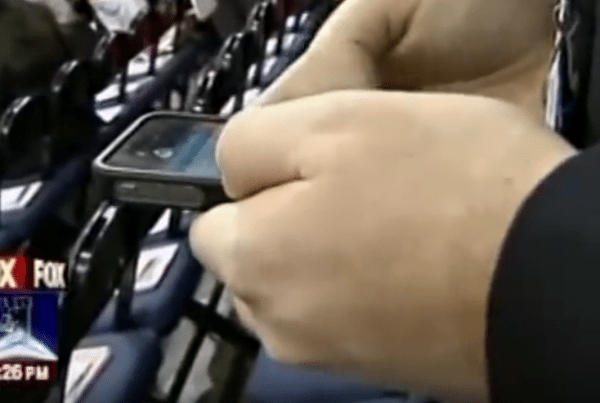Hand & Wrist
The hand and wrist consist of dozens of bones, joints, ligaments, tendons, and muscles that need to work together seamlessly in a variety of positions hundreds of times a day. As such, they often require highly specialized medical care when they become injured.
Carpal Tunnel Syndrome
Carpal tunnel syndrome is a condition that causes numbness, tingling, weakness and other symptoms in the hand and arm because of pressure on the median nerve in your wrist.
The median nerve and several tendons run from your forearm to your hand through a narrow passageway on the palm side of your wrist called the carpal tunnel. The median nerve controls movement and feeling in your thumb and first three fingers (not your little finger).
Pressure can come from swelling or anything that makes the carpal tunnel smaller such as health problems (hypothyroidism, rheumatoid arthritis, and diabetes), repetitive hand or wrist motions and pregnancy.
Tingling, weakness, numbness, or pain in the fingers or hand are some of the symptoms of carpal tunnel syndrome. They most often occur in the thumb, index finger, middle finger, and half of the ring finger. Some people experience pain in their arm between their elbow and their hand.
Proper treatment can relieve the tingling and numbness and restores wrist and hand function, starting with nonsurgical therapies.
Learn more about Carpal Tunnel SyndromeSolutions for Peripheral Nerve Injuries
Peripheral nerve injuries happen to more than 1.4 million Americans every year, with nearly 900,000 needing surgical intervention. In the past, surgeons have used the patient’s nerves from another part of their body to repair the damage. Now surgeons at Florida Orthopaedic Institute are pioneering nerve repairs with new products from AxoGen. Learn more about how AxoGen’s products are helping with peripheral nerve reconstruction.
Learn more about Nerve Pain SolutionsWRIST FRACTURES
The terms “wrist fracture” or “broken wrist” can be confusing or unclear because there are many bones in and around the wrist.
The most common type of wrist fracture is a distal radius fracture, which is a break near the wrist end of the long radius bone in the forearm. This fracture usually occurs as the result of a fall onto an outstretched hand.
There are several other possible types of wrist fractures that can occur. The second most common type of wrist fracture is a scaphoid fracture.
In the wrist, there are eight small round bones that sit in two rows, including the scaphoid bone. The scaphoid bone is near the base of the thumb, just above the long bone of the forearm, the radius.
Scaphoid fractures almost always are the result of a fall onto an outstretched hand but can also occur as the result of sports activities or car accidents.
Learn more about wrist fracturesThumb Ulnar Collateral Ligament (UCL) Injuries
Common among athletes, this injury happens when an ulnar collateral ligament (UCL) gets stretched too far or tears. The ulnar collateral ligaments are tough and flexible tissues that connect bones in the thumb.
Because skiers are prone to this injury when they fall with their hand strapped to a ski pole, it is sometimes called “skier’s thumb.” A thumb UCL injury can make the thumb feel unstable and be very painful. It can also limit movements, such as squeezing and gripping.
According to recent research, 49% of thumb ulnar collateral ligament injuries were caused by a fall onto an outstretched hand. Only 2.4% were due to skiing injuries, with sports accounted for most of the rest.
Learn More About Thumb Ulnar Collateral Ligament (UCL) InjuriesFRACTURED FINGERS
A broken or fractured finger is not a minor injury, even though the bones in the hand are small. The bones in the hand line up precisely so you can perform many specialized functions, such as holding small objects. A fractured finger bone can cause your whole hand to be out of alignment. Your broken finger might stay stiff and painful without treatment.
Approximately 6 million Americans suffer from at least one broken bone every year, and finger fractures account for up to 10% of all broken bones.
There is no difference between finger fractures and breaks. While some people believe that a “fracture” refers to a crack while a “break” is a separated bone, “fracture” is the term medical professionals use to describe any crack or break in a bone.
Fractured finger symptoms include swelling, tenderness, and bruising at the fracture site, inability to move the injured finger completely, and deformity of the injured finger.
Learn more about Fractured FingersFlexor Tendonitis
The flexor tendon connects the muscles to the bone in your hand. When there is a strain on the tendons flexor tendonitis can occur, making it difficult and painful to bend your thumb or fingers. Sometimes flexor tendonitis can stop hand movement altogether.
Learn more about Flexor TendonitisWALANT (Wide Awake Local Anesthesia No Tourniquet)
WALANT (Wide Awake Local Anesthesia No Tourniquet) is an operating technique that uses two medications (lidocaine and epinephrine) for some types of hand and wrist surgeries in a safe and painless manner. This technique eliminates the use of tourniquets and general anesthesia. WALANT has many advantages including no preoperative testing, no costs associated with anesthesia, no need for an IV, and a lower overall cost.
Learn more about WALANTSUDDEN (ACUTE) FINGER, HAND, AND WRIST INJURIES
Even though most of our movements don’t cause problems, minor injuries to the finger, hand, or wrist that cause pain or swelling are common. can develop from everyday wear and tear, injuries, or overuse.
Some of the more common finger, hand, and wrist injuries include bruises, sprains, specific injuries to ligaments (skier’s thumb), injuries to tendons (mallet finger), strains (pulled muscles), broken bones (fractures), crushing injury (leading to Compartment Syndrome and dislocations.
Learn more about Sudden (Acute) Finger, Wrist & Hand InjuriesUlnar Neuritis
Ulnar neuritis, also known as cubital tunnel syndrome, is an inflammation of the ulnar nerve in the arm that causes numbness or weakness in the hand. The ulnar nerve gives feeling to the little finger and half of the ring finger and is more commonly known as the “funny bone.” The ulnar nerve controls most of the small muscles in the hand that help with delicate movements and some of the bigger muscles in the forearm that help create a strong grip.
Activities that place constant pressure against the ulnar nerve at the elbow or wrist can cause ulnar neuritis. It can also be caused by repetitive motion at the elbow or wrist.
Learn more about Ulnar NeuritisTargeted Muscle Reinnervation (TMR)
Targeted Muscle Reinnervation (TMR) is a surgical procedure that gives amputees easier, more intuitive prosthesis control. The nerves to spare muscles of an amputated patient are cut and/or de-activated (denervated), then reinnervated with residual nerves of the amputated limb. EMG (Electromyography) signals of the targeted muscle can be used to drive motorized prosthetic devices. The reinnervated muscles serve as biological amplifiers of the amputated nerve motor signals, allowing for better control of sophisticated prosthetic arms.
Learn more about Targeted Muscle Reinnervation (TMR)Wrist Tendonitis
When a tendon — the thick fibrous cords that attach muscle to bone – is inflamed or irritated, the condition is called tendonitis. It causes pain and tenderness just outside a joint, like the wrist. Tendonitis can occur in any of your tendons.
Wrist tendonitis is a common condition characterized by irritation and inflammation of the wrist joint where many tendons surround the joint. Wrist tendonitis usually affects one of the tendons, but it can also involve two or more. Wrist tendonitis often occurs at points where the tendons cross each other or pass over a bony prominence.
Learn more about Wrist TendonitisWRIST SPRAINS
Wrist sprains can also result from accidents or falls around the home or work. They are also common and painful sports injuries.
Our natural instinct is to put our hands out to break a fall. In doing so, the wrist can get bent back, stretching, twisting, or tearing the ligaments connecting the bones in your wrist and hand. Wrists can also be sprained when there is a direct blow to the wrist.
To learn more about the symptoms, diagnosis and treatment of wrist sprains, click below.
Learn More About Wrist SprainsGANGLION CYSTS
Ganglion cysts, also called bible cysts, are noncancerous lump, often on the tendons or joints of wrists and hands. Ganglion cysts are common with more than 200,000 cases in the United States per year.
Ganglion cysts are round, small, and usually painless. They do not spread to other areas. Although rare, they can be painful if they press a nerve. In some cases, the cyst can interfere with joint movement.
The cause of ganglion cysts is unknown. A ganglion cyst often clears on its own. If troublesome, it can be drained or removed.
Learn More About Ganglion CystsDUPUYTREN’S DISEASE
Also called Dupuytren’s contracture, it is a gradual thickening and tightening of tissue under the skin in the hand. It is fairly common, with over 200,000 cases in the United States every year.
Over time, Dupuytren’s contracture (also known as palmar fibromatosis) can cause one or more fingers to stay bent toward the palm. This can complicate everyday activities, such as placing hands in pockets or shaking hands.
It can last for years or be lifelong and most often affects the ring and pinky fingers.
Learn More About Dupuytren's DiseaseTrigger Finger
Trigger finger, also called trigger thumb, is a condition in which a finger gets stuck in a bent position and then snaps straight. In the United States, there are more than 200,000 cases per year.
When the tendon in the affected finger becomes inflamed, trigger finger occurs. It most commonly effects women, people with diabetes or arthritis, and people whose regular activities strain their hands.
Symptoms can include stiffness, a popping or clicking sensation, and tenderness in the affected finger.
Learn More About Trigger FingerFINGER DISLOCATIONS
Finger dislocations are joint injuries that happen when finger bones move apart or sideways and out of normal alignment. They can happen when the bones of a finger are moved (dislocated) beyond their normal range of motion.
Finger dislocation is a common injury usually caused by a “jamming” force applied to the end of the finger, or the finger forcefully overextended. Either of these situations, and sometimes a combination of both, can result in a dislocation.
Learn More About Finger DislocationsRHEUMATOID ARTHRITIS OF THE HAND
Rheumatoid arthritis, also called RA, is a chronic inflammatory disorder affecting many joints, including those in the hand. In rheumatoid arthritis, the body’s immune system attacks its own tissue, affecting joint linings and causing painful swelling. Over time, the inflammation can cause bone erosion and joint deformity.
Rheumatoid arthritis is common, with over 200,000 cases in the United States every year. The condition can’t be cured but treatment can help. Physiotherapy and medication can help slow the disease’s progression. Many cases are managed with a class of medications called anti-rheumatic drugs (DMARDS).
Learn More About Rheumatoid Arthritis Of The HandWrist Arthroscopy
Wrist arthroscopy is a minimally invasive technique which can be used for diagnostic purposes as well as for therapeutic interventions. First introduced in 1979, wrist arthroscopy became accepted as diagnostic tool around the mid-1980s.
Wrist arthroscopy utilizes a small fiber optic instrument called an arthroscope that lets the surgeon to see inside the joint, without making large incisions into the muscle and tissue.
Learn More About Wrist ArthroscopyBasal Joint Surgery
Arthritis of the thumb happens when the thumb joint cartilage (carpometacarpal joint) wears away from the bone. This condition is also known as basal joint arthritis. Normally the cartilage acts as a cushion between the bones of the joint. When it is worn away, the direct contact and friction between the bones causes pain, swelling, decreased strength and limited range of motion.
Basal joint arthritis makes it difficult to grip and hold or twist objects between the thumb and fingers. It can be difficult to performing simple tasks such as turning a doorknob, opening a jar and pinching or gripping an item. Although it may be successfully treated with non-surgical options such as medications, severe cases of basal joint arthritis usually need surgery. Basal joint surgery removes and rebuilds the basal joint.
Learn More About Basal Joint SurgeryCOLLES’ FRACTURES (BROKEN WRISTS)
A Colles’ fracture is a type of fracture in which the broken end of the radius is bent backwards. Colles’ fractures typically occur from a fall on an outstretched hand, but risk factors also include osteoporosis. These types of fractures are also called broken wrists.
Colles’ fractures are common – about 15% of people have a Colles’ fracture at some point in time. Colles’ fractures occur more commonly in young adults and older people than in children and middle-aged adults, and in more women than men.
The fracture is named after Abraham Colles who first described it in 1814.
Learn More About Colles' FracturesDE QUERVAIN’S TENOSYNOVITIS
De Quervain’s tenosynovitis, also called radial styloid tenosynovitis is a painful condition that affects the tendons on the thumb side of the wrist. The condition can worsen with repetitive hand or wrist movements.
There are more than 200,000 cases of de Quervain’s tenosynovitis per year in the U.S.
Primary symptoms are pain and tenderness in the wrist, often below the base of the thumb.
The condition is treatable by a medical professional and requires a medical diagnosis, with lab tests or imaging usually not required.
LEARN MORE ABOUT DE QUERVAIN'S TENOSYNOVITISPeripheral Nerve Surgery (Hand) Revision
Several different reasons can cause hand-related nerve damage. Traumatic injuries are a common cause, such as a significant fall or a car accident. An underlying illness like Diabetes, Immune system deficiencies, bacterial or viral infections, tumors, or kidney and liver problems are also common factors.
Hand-related nerve damage can also come from repeated exposure to toxic chemicals, alcoholism, chronic use of certain medications, and certain vitamin deficiencies.
If you are experiencing symptoms that might suggest hand nerve damage, contact one of the hand specialists at Florida Orthopaedic Institute.
Learn More About Peripheral Nerve Surgery (Hand) RevisionHAND & FINGER REPLANTATION
For more than 50 years ago, thousands of severed body parts have been reattached, helping preserve the quality of life for thousands of patients through improved function and appearance.
Hand and finger replantation is the reattachment of a finger or hand that has been completely cut from someone’s body. The goal of this type of surgery is to give the patient back as much use of the injured area as possible.
Your surgeon may offer to clean, smooth, and cover the cut end (called a completion or revision amputation replantation) if the detached part is too damaged.
Learn More About HAND & FINGER REPLANTATIONHAND NERVE DECOMPRESSION
Nerve decompression surgery alleviates pressure on a nerve. It is done to either open any narrow spaces to give the nerve more room or remove whatever is pressing on the nerve, or both. Due to the surrounding skeletal structure, some nerves are more prone to compression than others
Peripheral nerve decompression is for conditions that begin somewhere other than the spine, while spinal nerve decompression surgery is in response to conditions caused by pressure on nerve roots in the spine.
Learn More About HAND NERVE DECOMPRESSIONREVASCULARIZATION OF THE HAND
Revascularization is the restoration of blood flow (perfusion) to a body part or organ that has suffered a restriction in blood supply to tissues (ischemia), causing a shortage of oxygen needed by your cells.
In hand revascularization, an experienced and skilled hand surgeon repairs injured or damaged blood vessels to fix damaged tissue and restore blood flow to as normal a level possible.
Blood vessel damage can be caused by a traumatic event (injury), disease, high blood pressure, or an obstruction (blockage).
Learn More About REVASCULARIZATION OF THE HANDHAND SKIN GRAFTS
Hand skin grafts are used to treat skin damaged by burns, infection, or other injuries. Sheets of healthy skin are removed from one part of the body (the donor site) and placed on the damaged hand. If possible, healthy skin is taken from areas not easily seen or that are usually covered by clothes.
There are two primary types of hand skin grafts: Split-Thickness Skin Graft (STSG) and Full-Thickness Skin Grafts. A split-thickness graft removes the epidermis (the top layer of the skin), as well as a portion of the dermis (the deeper layer of the skin). Full-thickness grafts use all the epidermis and dermis from the donor site. They are generally used for small wounds on highly visible parts of the body, as they blend in with the skin around them for a better cosmetic outcome.
Learn More About HAND SKIN GRAFTSTENDON TRANSFERS OF THE HAND
Tendon transfers restore lost hand function after the loss of muscle or tendon function from a nerve injury (cut, stretched, or torn nerve) or muscle injury (trauma, rheumatoid arthritis). Tendon transfers are also used for neuromuscular disorders (cerebral palsy, stroke, traumatic brain injuries, and spinal muscle atrophy) or congenital disabilities (infants born without certain muscle functions).
Tendon transfer surgery is also used when a muscle has ruptured or been lacerated and cannot be repaired.
Learn More About TENDON TRANSFERS OF THE HANDNewborn & Infant Pediatric Hand Clinic
Florida Orthopaedic Institute sees newborns and infant patients with congenital differences of the upper extremity, brachial plexus birth palsy, cerebral palsy, neuromuscular disorders, syndromes, and acute trauma and post-traumatic reconstruction
Led by Michael J. Garcia, M.D. and Alfred V. Hess, M.D., they have a combined experience of over 50 years.
To schedule an appointment, call (813) 978-9797, and specify “Pediatric Hand Clinic.”
FUNCTIONAL NERVE TRANSFERS OF THE HAND
When a nerve injury results in loss of muscle function or sensation, a functional nerve transfer is a surgical technique that is used to restore lost function and sensation.
Nerves with less important roles or branches of a nerve that perform redundant functions are surgically transferred to the nerve area that has been damaged.
The goal of a functional nerve transfer is to restore as much of the nerve’s function as possible. It can allow you to regain feeling and the ability to move and conduct basic activities.
Learn More About FUNCTIONAL NERVE TRANSFERS OF THE HANDFlorida Orthopaedic Institute’s Hand & Wrist center features the Bay Area’s greatest number of years of combined experience in hand and microvascular surgery. Our fellowship-trained microvascular surgeons provide the capability for complex reconstruction, as well as free tissue transfer and limb replantation.
Areas of Focus
- Hand & Wrist
- Basal Joint Surgery
- Carpal Tunnel Syndrome
- Colles’ Fractures (Broken Wrist)
- De Quervain's Tenosynovitis
- Dupuytren’s Disease
- Finger Dislocation
- Flexor Tendonitis
- Fractured Fingers
- Functional Nerve Transfers of The Hand
- Ganglion Cysts
- Hand & Finger Replantation
- Hand Nerve Decompression
- Hand Skin Grafts
- Nerve Pain
- Peripheral Nerve Surgery (Hand) Revision
- Revascularization of the Hand
- Rheumatoid Arthritis Of The Hand
- Sports Wrist and Hand Injuries
- Sprained Wrist Symptoms and Treatment
- Sudden (Acute) Finger, Hand & Wrist Injuries
- Targeted Muscle Reinnervation (TMR)
- Tendon Transfers of The Hand
- Thumb Ulnar Collateral Ligament Injuries
- Trigger Finger
- Ulnar Neuritis
- WALANT (Wide Awake Local Anesthesia No Tourniquet)
- Wrist Arthroscopy
- Wrist Fractures
- Wrist Tendonitis
The following Florida Orthopaedic Institute physicians specialize in Hand & Wrist:
Dr. Stone Talks About Texting Thumb
Dr. Stone talks to Fox 13 news about texting thumb, a condition he says can have your thumb running marathons every day. According to Dr. Stone, one pound of stress at the tip of your thumb multiplies dramatically as it travels up the bones, muscles, ligaments, and tendons of your arm.
Common Conditions
- Carpal Tunnel Syndrome (CTS)
- Colles Fractures
Common Procedures
- Basal Joint Surgery
- Endoscopic Carpal Tunnel Release
- Endoscopic Carpal Tunnel Release (LINS)
- Open Carpal Tunnel Release Surgery
Specialties
- AC Joint Injuries
- Achilles Tendinitis - Achilles Insertional Calcific Tendinopathy (ACIT)
- Achilles Tendon Rupture
- Achilles Tendonitis
- ACL Injuries
- Ankle Fracture Surgery
- Ankle Fractures (Broken Ankle)
- Ankle Fusion Surgery
- Anterior Cervical Corpectomy & Discectomy
- Arthroscopic Articular Cartilage Repair
- Arthroscopic Chondroplasty
- Arthroscopic Debridement of the Elbow
- Arthroscopy Of the Ankle
- Articular Cartilage Restoration
- Artificial Disk Replacement (ADR)
- Aspiration of the Olecranon Bursa - Fluid In Elbow
- Atraumatic Shoulder Instability
- Avascular Necrosis (Osteonecrosis)
- Bankart Repair
- Basal Joint Surgery
- Bicep Tendon Tear
- Bicep Tenodesis
- Bone Cement Injection
- Bone Growth Stimulation
- Bone Health Clinic
- Broken Collarbone
- Bunions
- Bursitis of the Shoulder (Subacromial Bursitis)
- Calcific Tendinitis of the Shoulder
- Carpal Tunnel Syndrome
- Charcot Joint
- Chiropractic
- Clavicle Fractures
- Colles’ Fractures (Broken Wrist)
- Common Foot Fractures in Athletes
- Community Outreach
- Cubital Tunnel Syndrome
- De Quervain's Tenosynovitis
- Deep Thigh Bruising
- Degenerative Disk Disease
- Diffuse Idiopathic Skeletal Hyperostosis (DISH)
- Discectomy
- Discitis Treatment & Information
- Dislocated Shoulder
- Dupuytren’s Disease
- Elbow
- Elbow Bursitis
- Elbow Injuries & Inner Elbow Pain in Throwing Athletes
- Epidural Injections for Spinal Pain
- Finger Dislocation
- Flexor Tendonitis
- Foot Stress Fractures
- Foot, Ankle & Lower Leg
- Foraminotomy
- Fractured Fingers
- Fractures Of The Shoulder Blade (Scapula)
- Fractures Of The Tibial Spine
- Functional Nerve Transfers of The Hand
- Ganglion Cysts
- General Orthopedics
- Glenoid Labrum Tear
- Golfer's Elbow
- Groin Strains and Pulls
- Growth Plate Injuries Of The Elbow
- Hallux Rigidus Surgery - Cheilectomy
- Hammer Toe
- Hamstring Injuries
- Hand & Finger Replantation
- Hand & Wrist
- Hand Nerve Decompression
- Hand Skin Grafts
- Hand, Wrist, Elbow & Shoulder
- Heat Injury/Heat Prostration
- High Ankle Sprain (Syndesmosis Ligament Injury)
- Hip & Thigh
- Hip Arthroscopy
- Hip Dislocation
- Hip Flexor Strains
- Hip Fractures
- Hip Hemiarthroplasty
- Hip Impingement Labral Tears
- Hip Muscle Strains
- Hip Pointers and Trochanteric Bursitis
- Hyperextension Injury of the Elbow
- Iliopsoas Tenotomy
- Iliotibial Band Syndrome
- Impingement Syndrome of the Shoulder
- Interlaminar Implants
- Interlaminar Lumbar Instrumental Fusion: ILIF
- Interventional Pain Management
- Interventional Spine
- Intraarticular Calcaneal Fracture
- Joint Replacement
- Knee & Leg
- Kyphoplasty (Balloon Vertebroplasty)
- Kyphosis
- Labral Tears Of The Hip (Acetabular Labrum Tears)
- Laminectomy: Decompression Surgery
- Lateral Collateral Ligament (LCL) Injuries
- Lisfranc Injuries
- Little League Shoulder
- LITTLE LEAGUER'S ELBOW (MEDIAL APOPHYSITIS)
- Lumbar Epidural Steroid Injection
- Lumbar Interbody Fusion (IBF)
- MACI
- Mallet, Hammer & Claw Toes
- Medial Collateral Ligament Injuries
- Meniscus Tears
- Metatarsalgia
- Minimally Invasive Spine Surgery
- Morton’s Neuroma
- Muscle Spasms
- Muscle Strains of The Calf
- Nerve Pain
- Neuromas (Foot)
- Neurosurgery
- Olecranon Stress Fractures
- Orthopaedic Total Wellness
- Orthopaedic Trauma
- Orthopedic Physician Or A Podiatrist? Definition of a Podiatrist
- Osteoarthritis of the Hip
- Osteoporosis
- Outpatient Spine Surgery
- Partial Knee Replacement
- Patellar Fracture
- Pelvic Ring Fractures
- Peripheral Nerve Surgery (Hand) Revision
- Pinched Nerve
- Piriformis Syndrome
- Piriformis Syndrome
- Plantar Fasciitis
- Plastic Surgery
- Podiatry
- Primary Care Sports Medicine
- Quadriceps Tendon Tear
- Radial Tunnel Syndrome (Entrapment of the Radial Nerve)
- Revascularization of the Hand
- Reverse Total Shoulder Replacement
- Rheumatoid Arthritis (RA) of the Shoulder
- Rheumatoid Arthritis Of The Hand
- Robotics
- Rotator Cuff Tears
- Runner's Knee
- Sacroiliac Joint Pain
- Sciatica
- Scoliosis
- Senior Strong
- Shin Splints
- Shoulder
- Shoulder Arthritis
- Shoulder Arthroscopy
- Shoulder Injury: Pain In The Overhead Athlete
- Shoulder Replacement
- Shoulder Separations
- Shoulder Socket Fracture (Glenoid Fracture)
- SLAP Tears & Repairs
- Spinal Fusion
- Spine
- Spondylolisthesis and Spondylolysis
- Sports Foot Injuries
- Sports Hernias (Athletic Pubalgia)
- Sports Medicine
- Sports Wrist and Hand Injuries
- Sprained Ankle
- Sprained Wrist Symptoms and Treatment
- Subacromial Decompression
- Sudden (Acute) Finger, Hand & Wrist Injuries
- Targeted Muscle Reinnervation (TMR)
- Tendon Transfers of The Hand
- Tennis Elbow Treatment
- Thigh Fractures
- Thigh Muscle Strains
- Thumb Ulnar Collateral Ligament Injuries
- Total Ankle Replacement
- Total Hip Arthroplasty
- Total Hip Replacement - Anterior Approach
- Total Knee Replacement Surgery
- Trapezius Strain (Muscle Strain of The Upper Back)
- Traumatic Shoulder Instability
- Tricep Pain & Tendonitis
- Trigger Finger
- Turf Toe
- UCL (Ulnar Collateral Ligament) Injuries
- Ulnar Neuritis
- Valgus Extension Overload
- Vertebroplasty
- WALANT (Wide Awake Local Anesthesia No Tourniquet)
- Whiplash and Whiplash Associated Disorder (WAD)
- Wound Care
- Wrist Arthroscopy
- Wrist Fractures
- Wrist Tendonitis
Services
- Physical Medicine & Rehabilitation
- Physical Therapy
- Primary Care Sports Medicine
- PROMs (Patient-Reported Outcome Measures)
- Same-Day Orthopaedic Appointments Now Available
- Sports Medicine
- Sports-Related Concussion Treatment
- Telehealth Page
- Telemedicine
- Workers' Compensation
- Workers' Compensation Dispensary
- X-Ray


